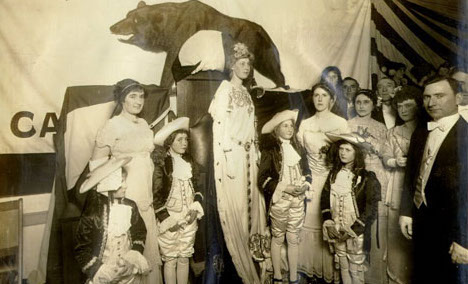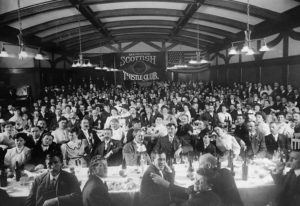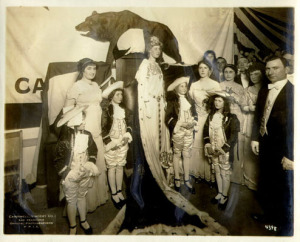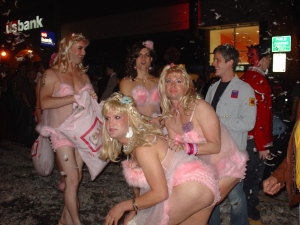
SF’s Gay Halloween – Part 1
San Francisco’s early embrace of Halloween

From practically the very beginning, San Franciscans have made a very big deal out of Halloween.
In the 1870s through the turn of the century, San Francisco proudly bore the nickname “Paris of the West.” It had more people of French descent than any other U.S. city except New Orleans, and more restaurants, many serving French cuisine, of any city in the world … except Paris. And capitalizing on this sentiment, the City of Paris Dry Goods Store was one of the City’s most important department stores from 1850 to 1976. (The store was demolished in 1980 but its rotunda was incorporated into the new Neiman Marcus store built on the same spot.)
But the term “Paris of the West” no doubt came more from the City’s cosmopolitan sophistication (in their minds, at least) than its population and cuisine.
The City went all out for Halloween, a tradition that appears to have been made popular in the U.S. by Irish immigrants. Groups like the Teamster’s Benevolent Society and the Scottish Thistle Club organized masked balls and costume parties for thousands of the City’s adults. Halloween was not just for kids, even back then.

Around the turn of the 20th century, merchants began organizing block parties with costume contests and ice cream eating contests, a tradition that Ernie DeBaca would revive on Castro Street in the 1940s. Streets in nearly every neighborhood were closed off for these block parties.
By the 1920s, huge costume carnivals were held in the Civic Auditorium. By the end of the 1930s, even during the Great Depression, parades and parties on Mission Street brought in crowds of more than a hundred thousand people – for a city that only had about 634,000 people.
The lights went out when World War II struck. Literally. Fears of air raids from across the Pacific forced black outs and curfews. San Francisco’s great Halloween parties wouldn’t come back until the mid-1950s, and by then the City’s growing gay population started to get into the act.
Halloween as a Gay Tradition

For generations, Halloween has been one of the High Holy Days for the gay community.
Today, gay enclaves throughout the country – like Key West in Florida, New York’s Greenwich Village, West Hollywood in Southern California, and the French Quarter in New Orleans – have turned informal Halloween parties into major civic celebrations with street closures and drinking in the streets. These parties didn’t just happen coincidentally. For decades, Halloween was the only gay holiday.
At a time when being identified as gay could mean losing one’s job, one’s family and friends, Halloween was a day when closeted gays could wear a mask and party incognito with their fellow gays. And for some, it was a day when they could take off their mask, metaphorically, and show a side of themselves they would usually keep hidden, safely dressing in drag or leathers because for one day it was “just a costume.” For once, even closeted gays could be as flamboyant as they wished. Perhaps, too, the holiday played into the stereotypical flamboyance and theatrics that were natural for some gay men.
It was a risky time to be gay. For a time, it was illegal for gays to be issued liquor licenses, or for bars to serve “known homosexuals.” When the California Supreme Court ruled in 1951 in Stoumen v. Reilly that gays had a right to congregate as long as they weren’t engaged in other illegal or immoral activities, San Francisco officials found other ways to harass gay bars, passing ordinances making it illegal for people of the same sex to dance together or even touch (much less engage in private sexual behavior, which would remain illegal until 1975), and prohibited people from impersonating the opposite sex with the intent to deceive.
Police routinely raided gay bars, arresting patrons and publishing their names, ruining lives in the process.
But Halloween was the one day of the year when the police stepped back and let the gays be free.
- Part 2 – The gays get into the Halloween spirit
- Part 3 – The party comes to SF’s gay downtown
- Part 4 – Halloween jumps to the Castro
- Photos of San Francisco’s Gay Halloween [external website, may not be safe for work]